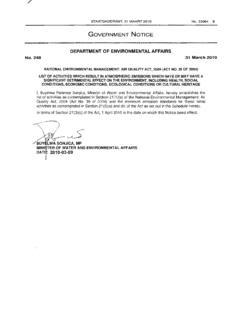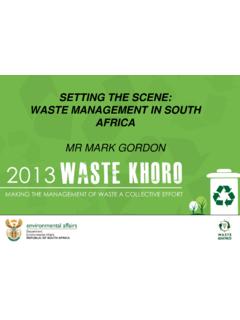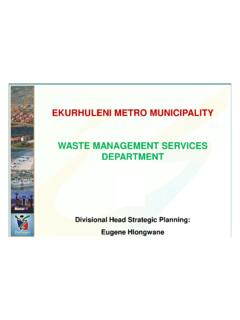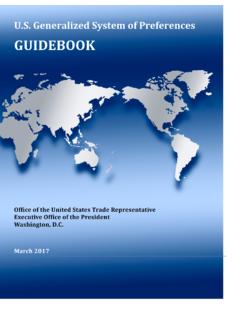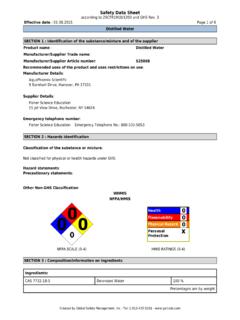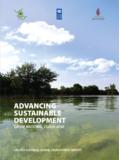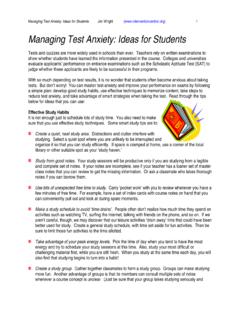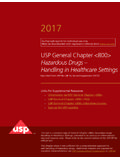Transcription of E: uneppub@unep.org Web: www.unep.org Modelling Report …
1 1 Job No. DTI / 1591 /GE South AfricaModelling Report ofUnited Nations Environment Box 30552, Nairobi 00100 , KenyaT: +254 (20) 762 1234F: +254 (20) 762 3927 E: on Natural Resource Management, Agriculture, Transport and Energy Sectors2 Copyright United Nations Environment Programme, 2013 This publication may be reproduced in whole or in part and in any form for educational or non-profit purposes without special permission from the copyright holder, provided acknowledgement of the source is made. UNEP would appreciate receiving a copy of any publication that uses this publication as a use of this publication may be made for resale or for any other commercial purpose whatsoever without prior permission in writing from , 2013, Green Economy Scoping Study: South African Green Economy Modelling Report (SAGEM) Focus on Natural Resource Management, Agriculture, Transport and Energy SectorsDisclaimerThe designations employed and the presentation of the material in this publication do not imply the expression of any opinion whatsoever on the part of the United Nations Environment Programme concerning the legal status of any country, territory, city or area or of its authorities, or concerning delimitation of its frontiers or boundaries.
2 Moreover, the views expressed do not necessarily represent the decision or the stated policy of the United Nations Environment Programme, nor does citing of trade names or commercial processes constitute promotes environmentally sound practices globally and in its own activities. This publication is printed on 100% recycled paper, using vegetable inks and other eco-friendly practices. Our distribution policy aims to reduce UNEP s carbon creditsDepartment of Environmental Affairs, South AfricaDepartment of Energy, South AfricaCover page: Blue solar batter cells , Salmonsdam Nature Reserve, Western Cape, South Africa Photosky/ShutterstockJune 2013 South African Green Economy Modelling Report (SAGEM)5 List of tables iiList of boxes iiList of figures iiList of acronyms iiiAcknowledgements ivForeword 1 Key messages 41 Introduction 62 Country profile 7 Economic and social profile 7 Environmental profile 83 Transformation to a green economy 9 Green economy - Origins and definitions 9 Key green economy interventions 9 Understanding green economy in the South African context 10 Sector priorities 11 Intervention priorities 134 Modelling a green economy for South Africa 14 Introduction 14 Overview of Modelling approaches 14 Characteristics of T21 15 Transparency 15 Comprehensiveness 15 Policymaking guidance 16 Strategy comparison 16 Long-term perspective 16 User-friendliness 16 Environmental analysis 16
3 Partnership building 17 National development indicators 17 Continuous time-series output 17 Applications 175 Applying T21 to the South African Green Economy Modelling (SAGEM) 18 Introduction 18 Developing a green economy model for South Africa 19 Boundary 20 Time horizon 20 Scope 20 Modules 20 Data collection 20 Environment sphere 22 Natural resource management 22 Land 22 Water 22 Energy 23 Emissions 23 Minerals 23 Society sphere 23 Population 23 Education 24 Health 24 Public infrastructure (access to roads and transport) 24 Employment 25 Economy sphere 25 Production (agriculture, services and industry) 25 Investment and households 27 Government 276 Scenario definitions and challenges 28 Scenario definitions 28 Challenges 297 Results of the simulation analyses 31 Baseline scenario (BAU) results 31 Results of green economy scenarios (GE2% and GETS)
4 33 Investment scenarios for key sectors 38 Natural Resource Management 38 Agriculture 40 Transport 40 Energy 408 Comparison of SAGEM and T21-World 42 Introduction 42 Comparison of the green economy analyses 42 Simulation of scenarios 42 Allocation of investments 42 Comparison of models 42 Selection of sectors 42 Structure of sectors 43 Data availability 43 Main results 449 Conclusions 46 References 48 Notes 49 Annex 1 51 Annex 2 52 Contents6 List of tablesTable 1 Focus sectors prioritised by workshop participants ..Table 2 Medium- and long-term targets ..Table 3 Green economy spheres and sectors ..Table 4 Modules of SAGEM .. Table 5 Data sources for SAGEM modules .. Table 6 Allocation of green investment across sectors in a green economy ..Table 7 Comparison of scenarios for the selected sectorsTable 8 Summary of the main indicators for 2012, 2020 and 2030.
5 Table 9 Main SAGEM indicators for the prioritized sectorsTable 10 Sources of date for T21-World models .. List of boxesBox 1 Basic data on South Africa .. Box 2 Comparison of economic and environmental consequences of the BAU2% and GE2% scenarios ..List of figuresFigure 1 Policy documents linked to green economy ..Figure 2 Structure of T21 ..Figure 3 The relationship between economic growth and natural resources ..Figure 4 Causal loop of effect of population on water demand ..Figure 5 Causal loop diagram Effects of green economy investment on agricultural production .. Figure 6 Comparison of real GDP in BAU with data ..Figure 7 Employment in the key sectors in BAU scenarioFigure 8 Comparison of population in BAU with data ..Figure 9 Selected land use changes in the BAU scenarioFigure 10 Comparison of CO2 emissions in BAU with dataFigure 11 BAU CO2 emissions in transport and power sectors.
6 Figure 12 Total employment in BAU, BAU2%, GE and GE2% scenarios ..Figure 13 Potential job creation benefits with respect to a high import scenario .. Figure 14 Comparison of share of renewable energy in BAU, BAU2%, GETS and GE2% scenarios .. Figure 15 Comparison of emissions in BAU, BAU2%, GETS and GE2% scenarios ..Figure 16 Comparison of centralised management and cost-based scenario in electricity pricing in GETSF igure 17 Comparison of centralised management and cost-based scenario in electricity pricing in GE2%Figure 18 Comparison of transport energy use in BAU, BAU2%, GETS and GE2% scenarios .. iiList of annexesAnnex 1 Modelling symbolsAnnex 2 Water quantity provision with WfW Potential electricity generation from invasive Land module .. Water supply module .. Water demand electricity generation module .. Coal electricity module .. Nuclear electricity module.
7 Hydroelectricity module .. Pumped storage electricity module .. Solar electricity module .. Wind electricity module .. Electricity generation technology share module .. Electricity price module .. Electricity demand module .. Oil demand module .. Gas demand module .. Air emissions module .. Minerals module (a) .. Minerals module (b) .. Population module .. Education module .. Health module .. Access to roads module .. Transport module .. Employment module .. Power sector employment module .. Agriculture module .. Industry module .. Services module .. GDP module .. Investment and household module .. Government module .. Page101220212629303641447351115182425313 232323333333438383939 Page515254565860626466687072747678808284 868890929496981001021041061081101121147 List of acronymsASPO-USA Association for the Study of Peak Oil and Gas BAU Baseline scenario (business-as-usual)
8 BAU2% Business-as-usual 2% scenarioCGE Computable General EquilibriumCRSES Centre for Renewable and Sustainable Energy StudiesCSP Concentrating Solar PowerDBSA Development Bank of Southern AfricaDC Disaggregated Consistency DEA Department of Environmental AffairsDME Department of Minerals and EnergyDoE Department of EnergyDTI Department of Trade and IndustryEIA Energy Information Administration FAO Food and Agriculture OrganizationGDP Gross Domestic ProductGE1% Green Economy 1% scenarioGE2% Green Economy 2% scenarioGER Green Economy ReportGETS Green Economy Target Specific scenarioGGND Global Green New DealGHG Greenhouse gasGW GigawattGWh Gigawatt hoursHA HectareIEA International Energy AgencyIRP Integrated Resource PlankW KilowattkWh Kilowatt hourME Macro-EconometricMFLE Male female life expectancyMI Millennium InstituteMIT Massachusetts Institute of TechnologyMW MegawattMWh Megawatt hourNDP National Development PlanNERSA National Energy Regulator of South AfricaNRM Natural Resource ManagementNT National TreasuryOECD Organisation for Economic Co-operation and DevelopmentPC Per capitaPGM Platinum Group MetalsPV PhotovoltaicRSA Republic of South AfricaSAGEM South African Green Economy Modelling reportSAM Social Accounting MatrixSAPS South African Police ServiceSARi South Africa Renewables initiativeSD System Dynamics SI Sustainability InstituteSTATS SA Statistics South AfricaTJ TerajoulesT21 Threshold 21 UNDP United Nations Development ProgrammeUNEP United Nations Environment ProgrammeUNFCC United Nations Framework Convention on Climate ChangeUSGS United States Geological SurveyWEF World Economic ForumWfW Working for WaterWPP World Population
9 ProspectsZAR South African Randiii8 The United Nations Environment Programme commissioned an analysis of the opportunities and options for a green economy transition, focusing on selected key economic sectors in South Africa, at the request of the national Department of Environmental Affairs. The analysis was conducted with technical assistance from the Millennium Institute and the Sustainability Institute, in collaboration with the Centre for Renewable and Sustainable Energy Studies (CRSES) of Stellenbosch University. The United Nations Development Programme supported stakeholder consultations and capacity building activities related to the implementation of the project. UNEP is grateful for the funding support provided by the European representatives of the following institutions led the project:Department of Environmental AffairsDorah Nteo (Programme advocacy)Godfrey Nyakhulalini (Project coordination)Lindiwe Tshabalala (Project coordination)Mapula Tshangela (Policy alignment)Millenium InstituteAndrea Bassi and Zhuohua Tan ( Modelling and Report preparation)Stellenbosch University and the Sustainability InstituteAlan Brent and Josephine Kaviti Musango ( Modelling and Report preparation)United Nations Development ProgrammeKibii KomenMaria MbengasheUnited Nations Environment ProgrammeMoustapha Kamal GueyeCecilia Kinuthia-NjengaThe following stakeholders participated and provided inputs that directed the project.
10 Agence fran aise de d veloppementFabio GraziAfrica Institute of South AfricaNedson PophiwaBritish American Tobacco South AfricaNoxolo MbanaCity of TschwaneCaiphus Chauke, Benjamin Manasoe, Matlhodi Maphutha and Thembi MkhabelaCouncil for Scientific and Industrial ResearchKristy Faccer, Maxwell Mapako and Henry NuwarindaDepartment of Agriculture, Forestry and FisheriesMatiga Motsepe and Nkosinathi NomatitiDepartment of Economic Development Gauteng ProvinceLebohang RaliapengDepartment of Economic Development, Environment, Conservation and Tourism North West ProvinceKgomotso GaobepeDepartment of Economic Development, Environment and Tourism Limpopo ProvinceMachoene Lilly Maja and Carol NkambuleDepartment of EnergyLindiwe ChaukeDepartment of Environmental AffairsAhmed Khan, Alfred Makhafula, Carina Malherbe, Wadzi Mandivenyi, Anna Mampye, Christo Marais, Nomusa Mbuyazi, Kiruben Naicker, Thembelihle Ndukwana, Xolisa Ngwadla, Thabang Nong, Faith Phooko, Guy Preston, Deborah Ramalope, Tlou Ramaru and Collins RamavhonaDepartment of International Relations and CooperationSuhayfa ZiaAcknowledgementsiv9 Department of Mineral ResourcesKgauta MokoenaDepartment of Science and TechnologyHenry Roman and Blanche TingDepartment of Trade and IndustryZakhele Mdlalose and Witness MokwanaDepartment of TransportJacob Dikgang and Shumani MugeriDevelopment Bank of Southern AfricaThierry Giordano and Kate Rivett-CarnacEconomic Development DepartmentLebohang Mothiba, Luzuko Ndzuta.


